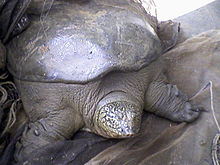Yangtze giant softshell turtle
| Yangtze giant softshell turtle | |
|---|---|
 |
|
| R. swinhoei of Dong Mo, Son Tay, Vietnam | |
| Scientific classification | |
| Kingdom: | Animalia |
| Phylum: | Chordata |
| Class: | Sauropsida |
| Order: | Testudines |
| Suborder: | Cryptodira |
| Family: | Trionychidae |
| Genus: | Rafetus |
| Species: | R. swinhoei |
| Binomial name | |
|
Rafetus swinhoei (Gray, 1873) |
|
| Synonyms | |
|
|
The Yangtze giant softshell turtle (Rafetus swinhoei) is an extremely rare species of softshell turtle found in China. It is also known as the Red River giant softshell turtle, Shanghai softshell turtle, or Swinhoe’s softshell turtle. In Chinese, it is known as the speckled softshell turtle (Chinese: 斑鱉; Pinyin: bān bīe). Only three living individuals are known (a fourth having been reported dead in January 2016), and it is listed as critically endangered in the IUCN Red List. It is hoped that a pair at Suzhou Zoo in China will breed.
The Yangtze giant softshell turtle is noted for its deep head with a pig-like snout and dorsally placed eyes. This critically endangered species holds the title of being the largest freshwater turtle in the world. It measures over 100 cm (39 in) in overall length and to 70 cm (28 in) in width, and can easily weigh up to 70–100 kg (150–220 lb). The average size of large turtle specimens (i.e. turtles weighing over 10 kg (22 lb)) that could be collected in the Yangtze River per one study was 25 kg (55 lb), although not all specimens were definitively identified as Rafetus. Its carapace, or shell, can grow larger than 50 cm (20 in), with the largest shell that could be found having measured 86 cm (34 in) in length. However, along the curve carapace lengths of up to 106 cm (42 in) have been reported and it is possible for the largest specimens (largely reported in Vietnam) to have weighed up 220 to 247.5 kg (485 to 546 lb). Its head can measure over 20 cm (7.9 in) in length and 10 cm (3.9 in) in width. The male is generally smaller than the female and has a longer, larger tail.
The Yangtze giant softshell turtle has been known to inhabit the Yangtze River and Lake Tai, situated on the border of Jiangsu and Zhejiang Provinces, in eastern China, and Gejiu, Yuanyang, Jianshui and Honghe in Yunnan Province in southern China. The last known specimen caught in the wild in China was in 1998 in the Red River between Yuanyang and Jianshui; it was then released. Only three living specimens are known, one at Dong Mo Lake Son Tay in Hanoi, Vietnam, (taxonomy questioned) and two in Suzhou zoo in China.
...
Wikipedia

